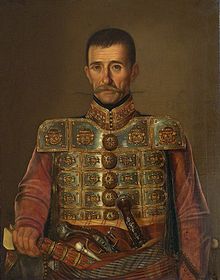Uzun-Mirko
| Uzun-Mirko Apostolović | |
|---|---|

Portrait by Uroš Knežević (ca. 1855)
|
|
| Native name | Узун-Мирко Апостоловић |
| Nickname(s) | Uzun-Mirko (Tall Mirko) |
| Born | 1782 Brajkovac (modern Serbia) |
| Died | 1868 (aged 85–86) Belgrade |
| Allegiance |
|
| Years of service | 1804 - 1817 |
| Rank | bimbaša, buljubaša |
| Battles/wars |
|
Mirko Apostolović, known as Uzun-Mirko (Serbian: Узун-Мирко Апостоловић; 1782–1868) was a Serbian voivode (military commander), with the bimbaša rank during the Serbian revolution; he took part in both the First and Second Serbian Uprising. He was famed for his many fatal wounds, undetected infiltration into the Ottoman fort at Belgrade, among other operations, which gained him many awards. He is the founder of the Uzun-Mirković family.
Mirko was born in 1782, in Brajkovac (then Smrdljikovac), near Lazarevac. His family were of the Piperi, and settled first in Rudnik, they then moved to Belgrade, and during the Austrian-Turkish War they lived in Srem. His father Petar Apostolović and grandfather Apostol died in the Austrian-Turkish War in 1792. They fought in Kočina Krajina, in the Austrian freicorps against the Ottoman Turks. At the return from Srem, Mirko and his mother lived in Mislođin, then he moved to Belgrade, where he learned to be a tailor. He received his nickname 'Uzun' from his height, the Turkish word for tall.
Uzun-Mirko reached fame when he participated in the Battle of Belgrade that took place from November 29 to December 12, 1806, when he together with his band and bimbaša Konda, a former mercenary commander serving the Ottomans in Belgrade, entered undetected in the city and from the interior opened the Sava Gate for the Serbian Army. He was seriously wounded during the fighting. He was wounded; in the head in Karanovac (1805, modern Kraljevo), in his left side in Paraćin (1805), in the shoulder in Smederevo (1805), in the right hand caused by knife in Sava (1806), in the hip in Užice (1805 or 1807), in the breast in Malajnica (1807), over the thighs caused by saber in Drina (1810). After the First Serbian Uprising, he rehabilitated in Wien. He also participated in the Second Serbian Uprising, in the battles of Lipar, Čačak and Dublje. When he sought a pension from the Sovjet (Serbian government) in 1842, they asked him for documents, upon which he answered "my documents are my 7 wounds!".
...
Wikipedia
